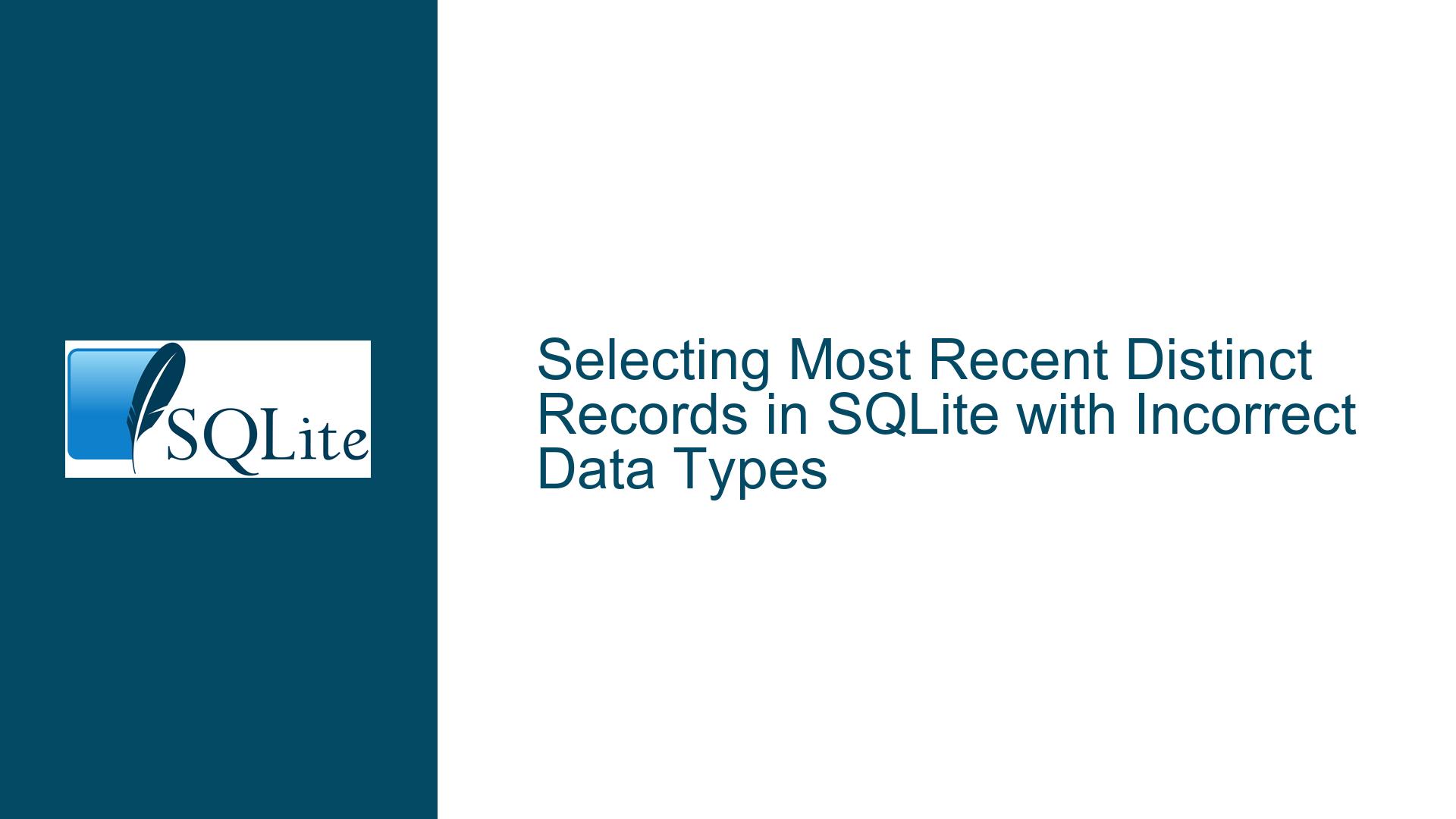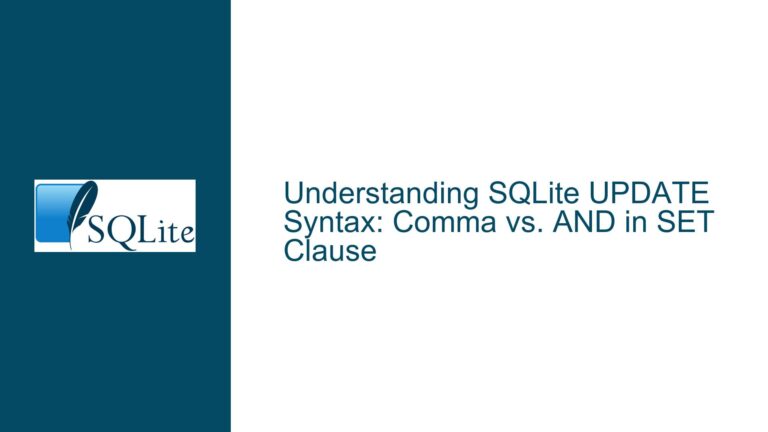Selecting Most Recent Distinct Records in SQLite with Incorrect Data Types
Incorrect Data Types in col2 Leading to Erroneous MAX() Results
When working with SQLite, one common issue that can lead to unexpected query results is the presence of incorrect data types in your columns. In this case, the user attempted to select the most recent distinct record based on col1, where the most recent record is determined by the highest value in col2. However, the query SELECT col1, MAX(col2) FROM t GROUP BY col1; did not yield the expected results. Specifically, the query returned 98000 as the maximum value for col1 BBB, even though there was a higher value of 154000 present in the data.
The root cause of this issue lies in the data type of col2. Although the values in col2 appear to be numeric, they were actually stored as text. In SQLite, when you perform a MAX() operation on a column containing text, the comparison is done lexicographically (i.e., based on the alphabetical order of the strings). This means that a string starting with 9 (e.g., 98000) is considered "greater" than a string starting with 1 (e.g., 154000), because 9 comes after 1 in the ASCII table.
To verify the data type of col2, you can use the typeof() function in SQLite. Running the query SELECT col1, col2, typeof(col2) FROM t; will return the data type of each value in col2. If the data type is text, then the MAX() function will not work as intended for numeric comparisons.
Lexicographical Comparison in Text Columns Causing MAX() to Fail
The issue arises because SQLite is a dynamically typed database, meaning that it does not enforce strict data types on columns. Instead, it uses a system of type affinity, where the type of a value is associated with the value itself, not the column. This flexibility can lead to situations where numeric values are stored as text, especially if the data was imported from a CSV file or another source that does not enforce strict typing.
When you attempt to use the MAX() function on a text column, SQLite performs a lexicographical comparison. This type of comparison is based on the ASCII values of the characters in the string, not their numeric values. For example, the string 98000 is considered greater than 154000 because the character 9 has a higher ASCII value than 1. This behavior is counterintuitive when dealing with numeric data, leading to incorrect results in queries that rely on numeric comparisons.
To further illustrate this, consider the following example:
SELECT MAX(col2) FROM t;
If col2 contains text values, this query will return the string that is lexicographically greatest, not the numerically greatest. In the user’s case, this query returned 98000, even though 154000 is numerically larger.
Converting Text to Integers and Using CTEs for Accurate MAX() Results
To resolve this issue, you need to convert the text values in col2 to integers before performing the MAX() operation. There are several ways to achieve this in SQLite, including using the CAST() function, Common Table Expressions (CTEs), or sub-queries.
Using the CAST() Function
The simplest solution is to use the CAST() function to convert col2 to an integer within the query. This ensures that the MAX() function operates on numeric values rather than text. The modified query would look like this:
SELECT col1, MAX(CAST(col2 AS INT))
FROM t
GROUP BY col1;
This query will correctly return the highest numeric value for each distinct col1. However, it is important to note that this approach will fail if col2 contains any non-numeric values (e.g., alphabetic characters). In such cases, you would need to clean the data before performing the conversion.
Using Common Table Expressions (CTEs)
Another approach is to use a Common Table Expression (CTE) to first convert col2 to integers and then perform the MAX() operation. A CTE allows you to create a temporary result set that can be referenced within the main query. Here is an example:
WITH tReal(c1, c2) AS (
SELECT col1, CAST(col2 AS INT)
FROM t
)
SELECT c1, MAX(c2) AS Latest
FROM tReal
GROUP BY c1;
In this query, the CTE tReal creates a temporary table with col1 and the integer-converted col2. The main query then selects the maximum value of c2 for each c1. This approach is particularly useful if you need to perform multiple operations on the converted data.
Using Sub-Queries
Alternatively, you can use a sub-query to achieve the same result. A sub-query is a query nested within another query, and it can be used to preprocess data before applying aggregate functions like MAX(). Here is an example:
SELECT S.c1, MAX(S.c2) AS Latest
FROM (
SELECT col1 AS c1, CAST(col2 AS INTEGER) AS c2
FROM t
) AS S
GROUP BY S.c1;
In this query, the sub-query S converts col2 to integers and aliases the columns as c1 and c2. The outer query then selects the maximum value of c2 for each c1. This approach is functionally equivalent to using a CTE but may be more familiar to users who are accustomed to traditional SQL syntax.
Permanently Fixing the Data Type
If you determine that col2 should always contain numeric values, you can permanently convert the column to integers using an UPDATE statement. This will ensure that future queries do not encounter the same issue. Here is an example:
UPDATE t SET col2 = CAST(col2 AS INT) WHERE 1;
This query converts all values in col2 to integers. However, you should always back up your data before performing such operations, as they cannot be easily undone.
Handling Non-Numeric Values
If col2 contains non-numeric values, you will need to clean the data before converting it to integers. One approach is to use a CASE statement to filter out non-numeric values. For example:
WITH tReal(c1, c2) AS (
SELECT col1,
CASE
WHEN CAST(col2 AS INT) IS NOT NULL THEN CAST(col2 AS INT)
ELSE NULL
END
FROM t
)
SELECT c1, MAX(c2) AS Latest
FROM tReal
WHERE c2 IS NOT NULL
GROUP BY c1;
In this query, the CASE statement ensures that only valid numeric values are included in the CTE. The WHERE clause in the main query then filters out any rows where c2 is NULL.
Conclusion
In summary, the issue of selecting the most recent distinct record based on col1 was caused by the incorrect data type of col2. By converting the text values in col2 to integers using the CAST() function, CTEs, or sub-queries, you can ensure that the MAX() function operates correctly. Additionally, permanently fixing the data type of col2 can prevent similar issues in the future. Always remember to back up your data before making any changes to your database schema or data types.






